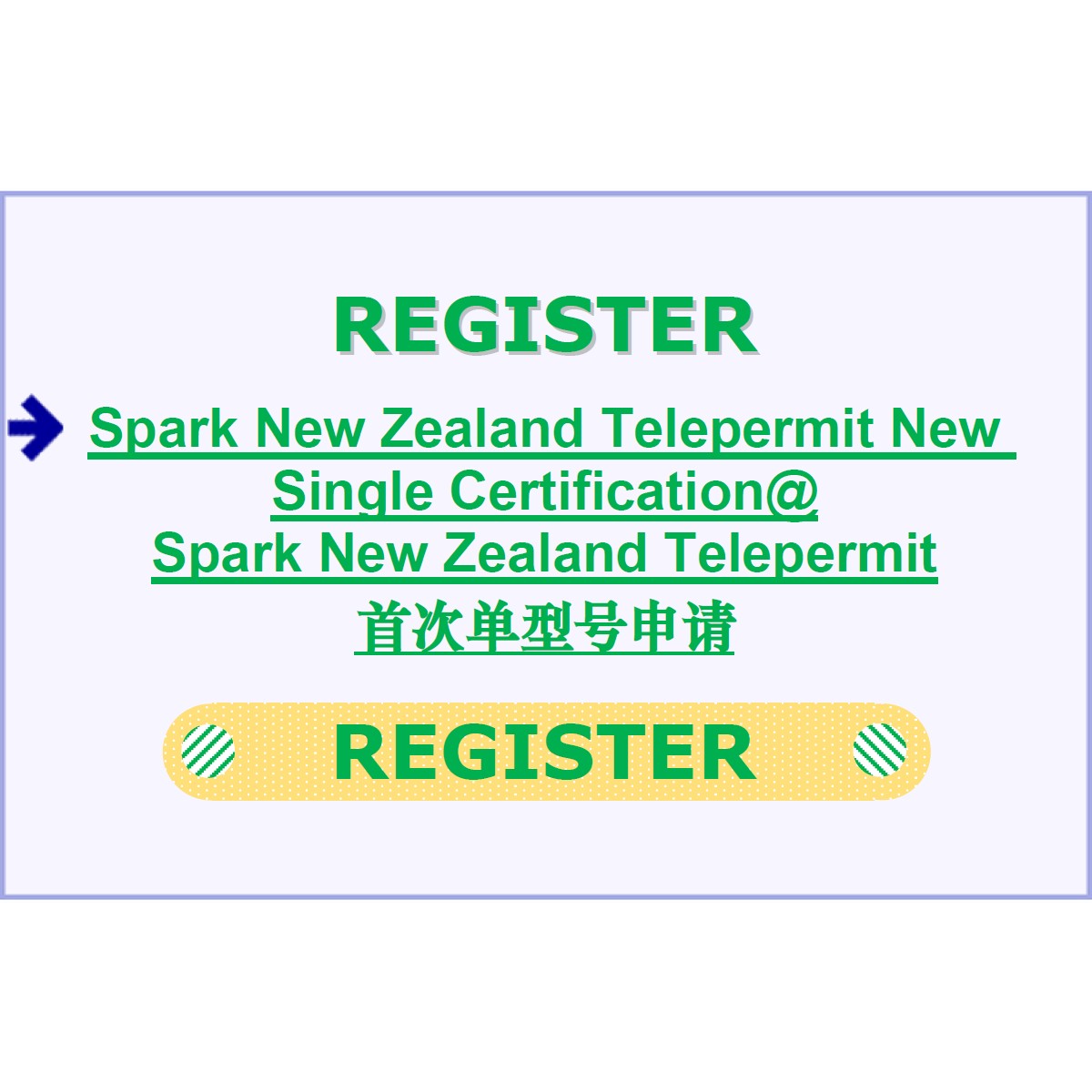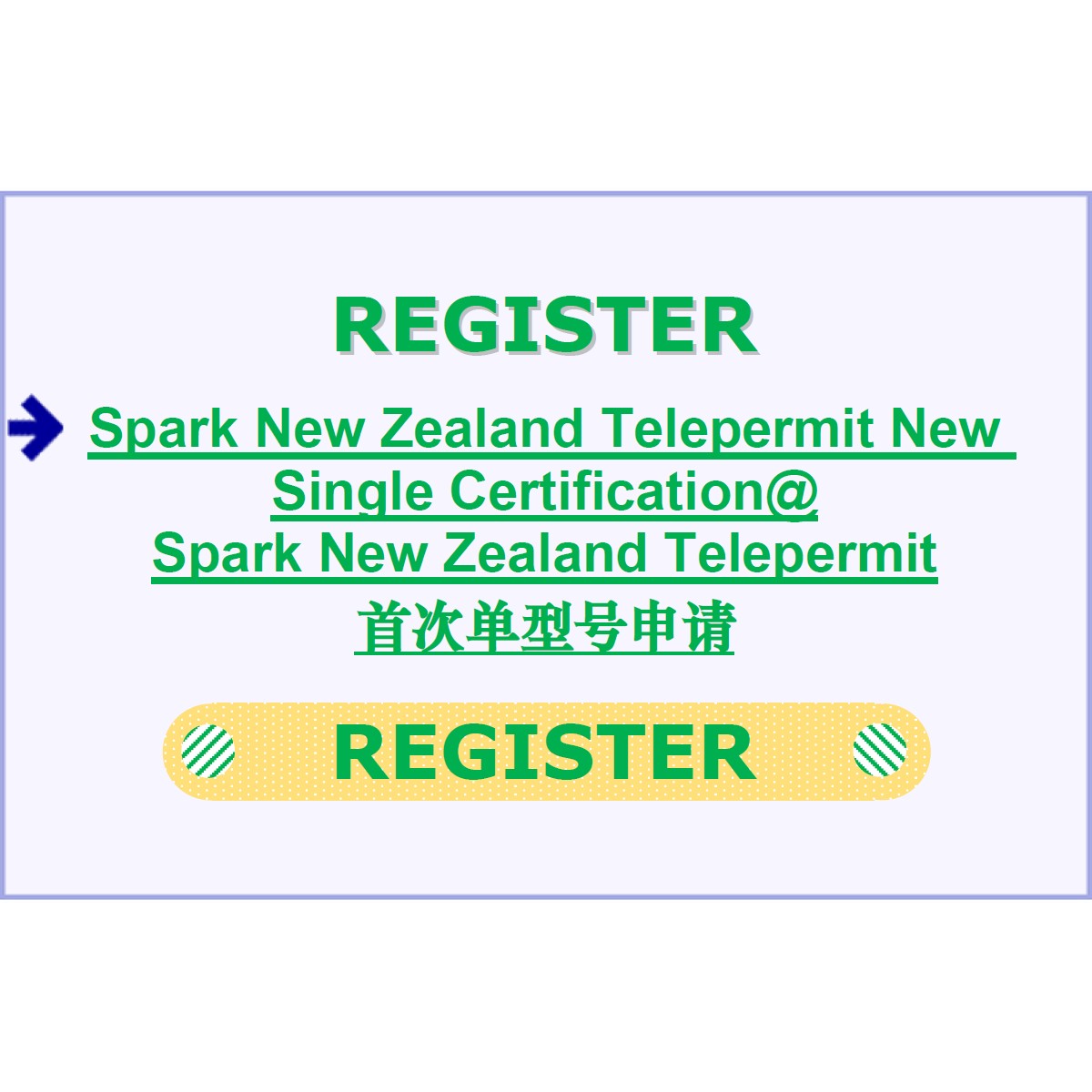New Zealand Telepermit Guide for Telecom
New Zealand Market Access for Telecom Approvals
In order to access the market of New Zealand, products must get all the required approvals established by the government of the country.
Telecom Approvals
Telecom approval — Telepermit
Equipment that is to be connected to the Public Switched Telephone Network (PSTN) in New Zealand requires a Telepermit from the network operator Spark New Zealand. Spark New Zealand also has technical standards that govern end-to-end communication characteristics of certain types of systems. Telepermits are typically issued based on review of test reports to demonstrate compliance with New Zealand standards.
The Telepermit is granted by either the Access Standards team or the Mobile team to the applicant when the product meets the PTC and TNA Specifications.
The applicant must be a New Zealand company.
When the Access Standards or Mobile teams are assured that the test results and the product meet the PTC/TNA specifications and all other requirements are met, a Telepermit may be granted. This grant includes provision of the Telepermit label artwork showing the allocated PTC number.
REGULATORY AGENCY
- Ministry of Economic Development
REGULATIONS
- A Telepermit indicates that a product may be connected to the Telecom New Zealand network.
- Testing should be performed by a Recognised Testing Authority according to Permit to Connect (PTC) specifications.
- Applications should be submitted to Telecom New Zealand’s Access Standards Team.
- Upon being granted with Telepermit, manufacturers are required to label products appropriately.
GUIDELINES
- A local representative is required.
CERTIFICATION PROCEDURE
- Submission of application, test report and essential documents.
- Assessment.
- Grant of Telepermit.
Permit to Connect Specifications
Permit to Connect (PTC) specifications describe the important characteristics necessary for compatibility of terminal equipment with Spark's networks. The specifications provide information for manufacturers who need to know how to design or modify a product to suit the New Zealand network.
PTC100 Spark Telepermit: General Conditions
PTC103 Spark Code of Practice for Residential-Type Customer Premises Wiring This document is retained for historical purposes only, and as a reference for those repairing legacy installations.
For all new installation work the TCF premises wiring code of practice shall be used
PTC106 Spark specification PTC106 has been withdrawn and replaced by a new wiring code of practice written and maintained by the Telecommunications Carriers' Forum.
The new document is: TCF Premises Wiring Code of Practice : February 2010.
It can be downloaded from the TCF site at:TCF premises wiring code of practice
PTC107 PABX External Port Interface Requirements
PTC131 Spark ISDN User - Network Interface, Layer 1: Basic Rate Interface
PTC132 Spark ISDN User - Network Interface, Layer 1: Primary Rate Interface
PTC190 Requirements for the connection of 0 - 4 kHz systems to metallic copper cable
PTC200 Requirements for Connection of Customer Equipment to Analogue Lines August 2019
PTC208 Specification of the PTC Requirements for Headsets for use in Telephony applications
PTC216 Specification of the PTC Requirements for Handsfree Conference Terminals: December 2017
PTC220 Requirements for Private Voice Networks connected to PSTN/ISDN/VoIP Public Networks
PTC222 1999 Spark Requirements for Customer Premises Cable (2 or 4 pairs with 0.5mm conductors)
PTC223 2004 Spark Requirements for 2-wire Jack Points for Residential Customer Premises
PTC225 2003 Draft Requirements for Star Wiring Boxes and Small Office/Home Office (SOHO) Cabling Installations
PTC226 V1.1 Spark Requirements for 2-wire 2 pin Sockets for Residential Use
PTC229 Interim Telepermit arrangement for connection to Spark Digital Voice Connect PBX SIP Trunking Service
PTC229 Specification for Customer Equipment connecting to Spark New Zealand Voice Connect SIP Trunking network
PTC251 Technical Requirements for Permission to Connect Radio Paging Receivers
PTC253 Technical Requirements for Connection of Trunked Mobile Radio Equipment
PTC257 Requirements for connection of WCDMA devices to the Spark New Zealand WCDMA network: September 2013
PTC257 Requirements for connection of WCDMA devices to the Spark New Zealand WCDMA network: September 2013_Addendum 1
PTC257 Requirements for connection of WCDMA devices to the Spark New Zealand WCDMA network: September 2013_Addendum 2
PTC273 Requirements for Connection of ADSL2+ CPE to Spark xDSL Network
PTC274 Requirements for Connection of VDSL2 CPE to the Spark VDSL2 Network
PTC281 Spark Requirements for Customer Connected ADSL2+ Line Filters
PTC285 Spark Requirements for Customer Premises VDSL2 Splitters
PTC331 Introduction to PTC331 2012 update
PTC331 Spark Network Interconnection using ITU-T no.7 Signalling Part A Introduction
PTC331 Spark Network Interconnection using ITU-T no.7 Signalling Part B Technical Definition of ITU-T Signalling System No.7 Message Transfer Part (MTP)
PTC331 Spark Network Interconnection using ITU-T no.7 Signalling Part C ISUP Specification Recommendation Q.763 - Message and Parameter Formats and Codes and Recommendation Q.764 - Signalling Procedures
TNA102 Characteristics of the Spark Analogue Telephone Network Customer Interface: August 2019
TNA133 Spark ISDN User - Network Interface, Layer 2
TNA134 Spark ISDN User - Network Interface, Layer 3 - Table of Contents
TNA134 Spark ISDN User - Network Interface, Layer 3 - Part A: General Matters
TNA134 Spark ISDN User - Network Interface, Layer 3 - Part B: Basic Call Control Procedures (Sections 1-2)
TNA134 Spark ISDN User - Network Interface, Layer 3 - Part B: Basic Call Control Procedures (Section 3)
TNA134 Spark ISDN User - Network Interface, Layer 3 - Part B: Basic Call Control Procedures (Section 4)
TNA134 Spark ISDN User - Network Interface, Layer 3 - Part B: Basic Call Control Procedures (Section 5)
TNA134 Spark ISDN User - Network Interface, Layer 3 - Part B: Basic Call Control Procedures (Sections 6 - 8)
TNA134 Spark ISDN User - Network Interface, Layer 3 - Part B: Basic Call Control Procedures (Section 9)
TNA134 Spark ISDN User - Network Interface, Layer 3 - Part B: Basic Call Control Procedures (Annex)
TNA134 Spark ISDN User - Network Interface, Layer 3 - Part B: Basic Call Control Procedures (Appendix)
TNA134 Spark ISDN User - Network Interface, Layer 3 - Part C: Generic Procedures for the Control of ISDN Supplementary Services
TNA134 Spark ISDN User - Network Interface, Layer 3 - Part D: Procedures for Specific Supplementary Services
TNA136 Primary Rate Lite
TNA137 Basic Rate Access - Ericsson AXE
TNA151 Spark Telephone Network Transmission Plan
TNA160 1991 General Installation and Earthing Requirements for Customer Switched Systems
△ The above picture and text are from the Internet. If there is any infringement, please contact us in time and we will delete it immediately.
As the first global market access digital platform, BWTCmall.com offers a new and unprecedented online service experience for its many users.
As a technology-driven company, BWTCmall.com is committed to developing a powerful and scalable platform that not only enables global manufacturers to quickly and accurately find the best way to reach the global market, but also to experience cost-effective cutting-edge technology and services. Let the global market access market truly enter a virtuous circle of fairness, objectivity, harmony and win-win.
Please visit the solution for get your best way of testing and certification / approvals to the target market.










